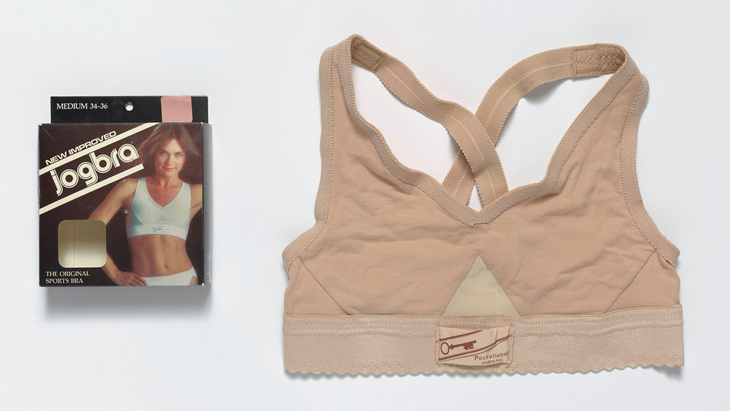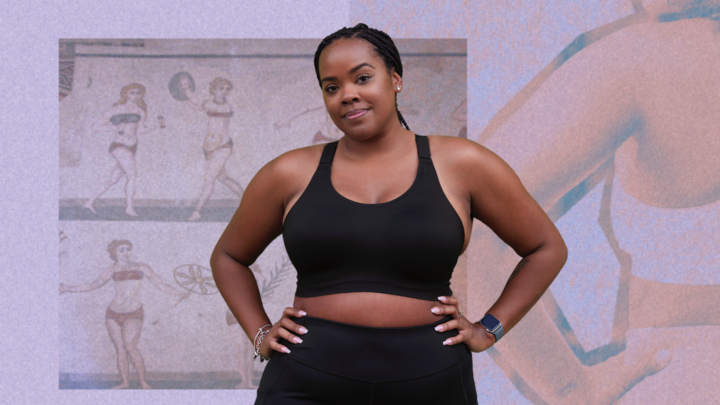Products You May Like
Get access to everything we publish when you
sign up for Outside+.
For many women, physical activity was fun–until puberty. Newly developed breasts meant experiencing a novel pain with the sports we long loved. Playtime was over.
A 2016 survey of more than 2,000 adolescent girls in the UK found 46 percent reported that their breasts affected their participation in sports. In the same survey, 73 percent reported at least one breast-specific concern, relating to the sports they played.
It’s not uncommon for women to feel pain while running due to improper support of their breasts. A review, published in Exercise and Sports Sciences Reviews, notes that a woman who runs at a cadence of 160 strides per minute, experiences her breasts bouncing approximately 9,600 times in an hour-long run.
A supportive bra may not only reduce pain, but research shows that it could also improve a person’s biomechanics, improve their running economy, and positively affect their stride.
This paramount piece of equipment hasn’t been around nearly as long as, say, running shoes. That late 19th century invention has benefited from more than 150 years of tweaking and perfecting to the point that the highest level of products have become known as “super shoes.” Let’s take a look at where sports bra innovation has been and where it still needs to go.
The Beginning
Evidence of bra-like garments dates back to 1400 B.C., but bras as we know them today weren’t mass-produced until the 1930s. Sports bras wouldn’t come around for much longer.
Despite the discomfort, female runners made do with what they had. Like Bobbi Gibb, the first woman to run the Boston Marathon in 1966, did so wearing a tank top bathing suit to compress breast movement.
It wasn’t until 1975 that the first bra designed specifically for athletic use was released. Glamorise, a company that had made brassieres since 1921, made the first known sports bra—the Free Swing Tennis Bra. Not just for tennis, advertisements of the product let customers know the bra could also be used for skiing, bowling, skating, sailing, riding, and cycling, too!
Though it was made from stretchy and supportive performance-oriented materials (Lycra Spandex), it still resembled a fashion bra with thin straps and frilly embellishments. It wasn’t ideal, but it was a start.
The first truly innovative sports-oriented bra hit stores a few years later with the debut of the Jogbra. It was the late 1970s and jogging was trendy. Lisa Lindahl, a 29-year-old University of Vermont graduate student, tried it for the first time and knew that running was for her. She loved it. She didn’t love the lack of breast support, though.
In 1977, Lindahl teamed up with Polly Smith, a childhood friend who had degrees in fashion and costume design, to create a prototype. Lindahl imagined her athletic bra would have stable straps and compression to prevent excessive movement and be made from a breathable, chafe-free fabric.
After several attempts, the infamous first working prototype was two jockstraps—a piece of supportive sports apparel invented for men in 1874–sewn together to serve as a pair of breast cups with shoulder straps. It was originally nicknamed the “jockbra” but Lindahl eventually coined the name “Jogbra” and it stuck.
They evolved and improved their initial designs, which did a good enough job at the time—especially compared to anything else that was available to women athletes—but there was no scientific testing to prove its performance value, as is the standard today.
In 1978, Dr. Christine Haycock, an associate professor of surgery at the University of Medicine and Dentistry of New Jersey, published the first research on breast biomechanics to better understand what was causing women pain while exercising.
Based on her research, Dr. Haycock recommended that sports bras have the following qualities: constructed with a firm, non-elastic, material that is absorptive; provide firm support; no seams near the nipples; no metal or plastic clasps touching the skin; and the ability to add padding to reduce traumatic injury in contact sports.
As the original American running boom gained momentum, more and more women were getting involved and the Jogbra became a staple of the small but growing women’s running movement. Another friend of Lindahl and Smith, Hinda Miller, came in to help grow Jogbra Inc. (JBI) to the industry leader it quickly became, selling first in running specialty stores and later department stores. According to the United States Patent and Trademark Office sales topped $500,000 in the initial year.
On November 20, 1979, the Jogbra—with its compression front panel, elastic straps, and wide supportive rib band—was issued its first patent. It was made from cotton, polyester, and Lycra for comfort, durability, and support.
Although competing brands emerged, Jogbra became a cultural phenomenon that, in addition to providing comfort and support for running, also represented the freedom for women to participate in sports and a sense of modern athletic feminine style. Not only did Jogbras not resemble traditional lingerie, but they were offered in a wide range of colors.

The Middle
As time went on, other sports brands started to recognize women as a worthwhile target demographic.
Moving Comfort, one of the largest brands of the 1980s, 1990s, and early 2000s, can trace its roots back to 1977, when runners Ellen Wessel and Elizabeth Goeke stitched together custom-made running clothes on a Singer sewing machine.
In 1979 Nike, then a nascent sports apparel and footwear brand, introduced its first women’s athletic wear line. The company began studying breast motion in women in the 1990s at the Nike Sports Research Lab, and it eventually led to the development of the first compression sports bra in 1999.
By the 1990s, women’s sports apparel was booming. JBI was sold to bigger players: first to Playtex in 1990, then the Sara Lee Corporation in 1991 and eventually becoming the Champion Jogbra Division. Moving Comfort was eventually purchased by Brooks in 2007.
But by the early 2000s, sports bras were still not reaching their full potential.
“When I started in the industry, there were very few options [still],” says Julianne Ruckman, senior manager of apparel product line management at Brooks. Ruckman has been contemplating sports bra design since 2003, when she worked with Harpo Studios to outfit women for transformation segments on the Oprah Winfrey Show. She remembers the options available having stiff components, adjustability in the wrong places, lack of size variety, and were generally unappealing.
Slowly, brands designing sports bras for bigger-breasted women began to take space in the industry. Prior to that, styles existed in the range of extra small to extra large, Ruckman recalls.
“I can tell you, if I put a lineup of six different 34Ds, they’re going to carry their tissue and look very different.”
Narrow sizing doesn’t work for the array of body types in the world, Ruckman insists. (As an example, Brooks has 46 unique sizes across two collections of sports bras today.)
A lot of the changes that have been made to sports bras aren’t visible. In the 1990s and 2000s era of bra design, every component was visible with chunky seams connecting “comfort stretch panels” to “support panels” like a puzzle made of a patchwork of materials. Sports bras on the market today look and feel more simplistic by design.
“It may have looked like we walked away from support, because you didn’t see all of the same work, you didn’t see where things were engineered in,” Ruckman says. Now bras have more internal engineering and are made from advanced material that can alternately provide comfort, support, compression, and style.
Over the duration of Ross Weir’s career consulting on sports bra research and development, he’s seen brands invest more in their teams to create better products.
“Twenty years ago it was unlikely we would be working with a biomechanist within the brands team, but today it’s not all that uncommon,” says Weir, co-founder of Progressive Sports Technologies, a sports tech and apparel consulting firm. “We also see roles like anthropologist, mechanical engineer, and materials scientist in these product development teams.”
Today, runners have access to the most advanced breast support in history. Brands still have interest in innovating. In 2017, released the Enlite Bra, launching an era of smart designing and fabrics that allow for more natural movement of the breasts and responsiveness.
Nike has taken their process a step further, unveiling a robotic mannequin capable of sweating that mimics the soft tissue in breasts in 2022. The tech is being used to test new sports bra designs without relying on human models. The brand has also revealed that it is using data visualization and avatars to take into consideration the wide range of curves, heights, and body weights of sports bra wearers.

The End?
Nearly 50 years later, the invention of the sports bra is still being celebrated. In 2019 Lindahl wrote a memoir called Unleash The Girls: The Untold Story of the Invention of the Sports Bra and How It Changed the World (and Me) that told stories about women in business dealing with success, power issues, and personal growth. Three years later Lindahl, Smith, and Miller were inducted into the National Inventors Hall of Fame for their achievement in developing the world’s first functional sports bra.
However, even with all the advancements since the first designs, more than 40 percent of both physically active women and elite female athletes report still experiencing breast-pain during physical activity, suggesting that sports bras have not hit the mark of what they are designed to do.
A survey of women in Australia found that straps—either slipping off or digging in—are rated the most problematic feature. Tightness around the chest was the next feature women disliked most.
Have sports bras come as far as they reasonably can?
Weir notes that it’s not uncommon for a woman who finds a sports bra comfortable to relax in, will find it uncomfortable during physical activity and vice versa.
“Comfort is a simple word for a complex sensation. It continually evolves as we interact with products, especially our clothing,” he says. Women want to be able to go from one activity to the next without changing bras.
According to the Exercise and Sports Sciences Reviews paper, the next level of breast support may come from electromaterials that can sense changes in breast movement and adjust the level of support automatically.
Ruckman notes that solving for variability in breast sizes within a single person—factoring in that the left and right breast can be different cup sizes and that breast size can change over the course of a month due to the menstrual cycle—and improving on/off maneuverability are top priorities for sports bra designers right now.
“Support is the expectation, comfort is the goal,” says Ruckman.
To see a melding of the competing desires, Weir notes that consumers may have to pay higher prices for sophisticated solutions to truly balance comfort and support.
“I have no doubt that the product could be rapidly improved and custom fit be offered if the consumer’s sentiment changed to value the sports bra in the same way as sports shoes,” he says. “This is one of the biggest barriers the sports bra sector faces in bringing new innovative products to market.”
The quest to build a better sports bra still continues.
